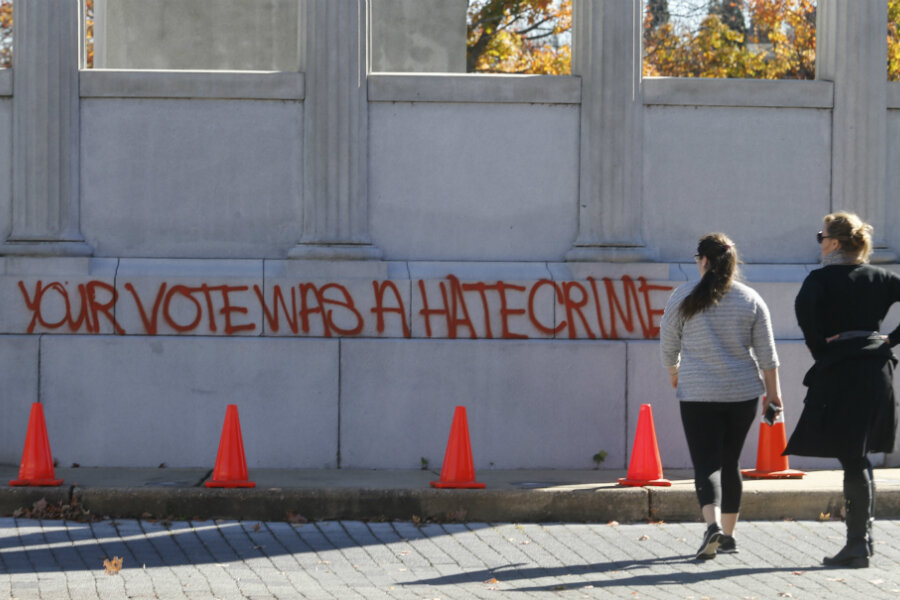What do the SPLC's post-election hate-incident reports mean?
Loading...
After documenting more than 860 reports of hate-related incidents across the United States in the 10 days following the elections, civil rights groups have called upon President-elect Donald Trump to take responsibility for the apparent flood of hatred and publicly denounce racism and bigotry as un-American.
The Southern Poverty Law Center (SPLC) culled media reports and collected complaints directly from victims to assemble two documents released this week that summarize incidents of hatred toward black Americans, immigrants, Muslims, LGBT people, women, Jews, and others. SPLC President Richard Cohen said the list of such accounts – which shows a peak of more than 200 hate incidents on Nov. 9, the day after the election – is "the predictable result" of Mr. Trump's inflammatory campaign.
"Rather than feign surprise, Mr. Trump should take responsibility for what’s occurring, forcefully reject hate and bigotry, reach out to the communities he’s injured, and follow his words with actions to heal the wounds his words have opened," Mr. Cohen said in a statement.
The SPLC's database is limited to "real-world events," meaning researchers excluded instances of online harassment. And although they omitted reports that were deemed to be hoaxes, researchers noted it would be impossible to "confirm the veracity of all reports." This means the database, though it provides a great deal of anecdotal evidence to support the SPLC's position, is of limited utility to statisticians.
"Without data from the ten days prior to the election it is hard to know what sense to make of post-election data," John Laub, professor of criminology at University of Maryland, College Park, tells The Christian Science Monitor in an email.
An increase in hate-incident reports, furthermore, does not necessarily mean there was an increase in hate incidents, even if every report in the database is valid, Dr. Laub adds.
Phyllis Gerstenfeld, author of two books about hate crimes and a professor of criminal justice at California State University, Stanislaus, says a estimates suggest more than two-thirds of hate crimes go unreported under normal circumstances. In light of that fact, the SPLC data is meaningful, despite its statistical limitations, she says.
"What I see is that there is a perceived increase in hate incidents, but whether that reflects reality is almost impossible to tell," Dr. Gerstenfeld tells the Monitor. "There’s certainly cause for concern, but trying to track hate crimes or hate incidents is just notoriously difficult."
The Federal Bureau of Investigation keeps tally of hate crimes across the United States, but the organization's data are based on voluntary reporting from other agencies, which are distributed across 50 states with varying legal definitions for what constitutes a hate crime. And it takes a long time to process and publish the information gathered.
Not until Nov. 14 did the FBI release last year's hate crime statistics, and those numbers exclude incidents of hate speech that were not crimes. Katayoun Kishi, writing for Pew Research Center, noted that these data show the number of physical assaults against Muslims in the US reported in 2015 rose nearly to the levels seen in 2001.
Trump's campaign has clearly reinvigorated radical right-wing movements, at least indirectly, in recent months as they have grown more active and vocal, Gerstenfeld says, even if researchers lack sufficient quantitative data to prove that fact conclusively.
Richard Arnold, political science professor at Muskingum University in New Concord, Ohio, says it seems likely that Trump's campaign rhetoric had a widespread impact, as SPLC says.
"Obviously, causation is very hard to prove, very hard to demonstrate," Dr. Arnold tells the Monitor.
Arnold, an American citizen who was raised in Britain, says the recent flood of post-election hate-incident reports resembles widespread reports of racist leaflets, graffiti, and limited violence that immediately followed the Brexit referendum, in which a narrow majority of UK voters decided to cut ties with the European Union, amid a rise in xenophobic and nationalist sentiments across the continent.
In the 38 days following the Brexit vote, there were more than 2,300 recorded race-related hate crimes in London, up from 1,400 in the 38 days prior to the referendum, as The Guardian reported.
Jack Levin, co-director of the Brudnick Center on Violence and Conflict at Northeastern University in Boston, says these surges in hate reflect a pattern. The pattern reared its ugly head, he says, in 2001, against those perceived as Muslim or Middle Eastern following the 9/11 terrorist attacks; in 2004, against gays and lesbians with the passage of same-sex marriage in Massachusetts; in 2009, against black people as President Obama began his first term; and in 2010, when Hispanic and Latino groups were victimized as unemployment peaked amid concerns over illegal immigration swelled.
"Whenever there is a threat to the survival, the employment, the culture, the religion of the dominant group, we see an increase in hate crimes against the group that’s threatening. And that has been true for hundreds of years, nothing new about that," Dr. Levin tells the Monitor. "But there is something new about these recent statistics."
The an increase in the perceived threat didn't did not immediately precede the most recent slew of hate-incident reports, but Trump's election did, and some Americans saw his rhetoric as supportive of such hate offenses, Levin says.
"I think it was that sympathy from a powerful political figure that may have inspired ordinary Americans who were fearful of immigrants and blacks and Latinos and Muslims to seek revenge, to get even by perpetrating hate crimes on their own," Levin adds.
In an interview on "60 Minutes," Trump told his supporters to "stop it" with the hate, and in an interview with The New York Times, he denounced white supremacists. But the SPLC, joined by the Leadership Conference on Civil and Human Rights, the National Council of La Raza, and the American Federation of Teachers (AFT), says Trump should do more.
"A president-elect has to create a climate that keeps all Americans safe," AFT President Randi Weingarten said.
Schools and universities were the most common location for hate incidents to occur, most often through graffiti and verbal harassment, according to the SPLC reports. A mother in Colorado, for instance, said her 12-year-old daughter was approached by a boy who said he would "shoot you and all the blacks I can find" now that Trump is president. A teacher in Washington State reportedly heard the slogan "Build a wall" chanted in their lunchroom on Nov. 9.
"This polarized and divisive election has left its mark on all of us, but most tragically on our children," Janet Murguia, president of the National Council of La Raza, said. "We have heard countless stories of harassment, intimidation and bullying of Latino and other students in schools around this country. This cannot stand."
The number of reported incidents slowed in the days following the election, but Americans should not expect them to vanish.
"It's not just going to go away," said Cohen, the SPLC president.
Brenda Abdelall, charities program director of Muslim Advocates, said the groups expect to encounter even more hate-related incidents as Inauguration Day approaches. And that's something the president-elect should seriously consider as he sorts through his campaign promises to determine which should be codified into actual policy positions.
"To bring us together as a nation," Ms. Abdellal said, Trump "will need to disavow dangerous proposals and ideas that single out and demonize Muslims and other communities."
Material from The Associated Press was included in this report.








